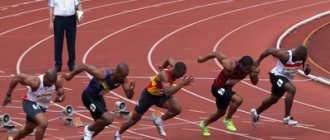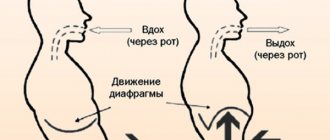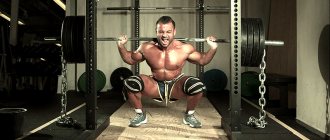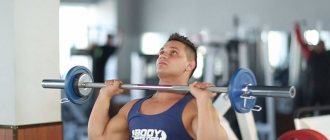We have already published the most effective training for muscle growth from scientists: recommendations on weight, number of repetitions, rest and other aspects - based on scientific research. We've now adapted texts from leading fitness experts on how to most effectively build strength.
About PM (“Repeat Maximum”)
The weight of the weight is indicated as a percentage of the maximum weight with which you can perform one repetition without losing technique (indicated by 1RM or simply RM). In addition, the load is sometimes designated by several amounts of RM7. For example, if with a barbell of 100 kg you can perform only 10 repetitions at maximum effort, then the intensity with a barbell of 100 kg is 10 RM. And here we need to make an important note: only performing the approach “to failure” means performing 10 repetitions with an intensity of 10 RM.
But how can you find out your 1RM if fitness experts prohibit beginners from doing exercises “all the way”? Use the fitness strength calculator:
What weight of barbell to increase strength with?
an intensity of 60-70% of 1RM is needed for resistance training . Roughly speaking, if your maximum barbell weight with which you can squat once is 100 kg, then the most effective training weight for increasing strength is 60-70 kg.
Scientists confirm: according to the results of a meta-analysis (Rhea et al, 2003), the optimal intensity for untrained (less than a year of continuous training) is 60% 1RM .
Significant increases or decreases in weights relative to 60% RM should not be used. The effectiveness of training in untrained subjects decreased at an average training intensity of 80% 1RM .
For people with a high level of fitness, the ACSM recommends an intensity of 80-100% 1RM to increase strength..
From theory
Doctors have determined that any human motor activity is determined by the work of the central and peripheral parts of the nervous system. The brain sends a signal to the skeletal muscles, tissues begin to contract, and various parts of the human body begin to move. The energy with which a person takes steps, waves his arms, shakes his head, etc. is called muscle strength - we will explain the principles of its development in this material. The better the muscle tone, the easier it is for them to respond to external resistance (gravity, the weight of their own body and additional weights, blows from the enemy) and, accordingly, the more powerful the athlete is considered. Typically, in the theory of physical culture, four types of strength are distinguished:
- Depreciation
. It occurs when an athlete's muscles perform short-term work in a yielding mode (for example, when running over obstacles or pole vaulting). - Slow
. It is necessary in situations where human muscles are extremely tense under weights and do not contract for an extended period (for example, when performing a one-arm plank or deadlift with a barbell). Developing this type of muscle strength requires special attention. Holding dumbbells or kettlebells for too long can lead to sprains and even tears in ligaments. - Explosive
. It is used when a man or woman overcomes resistance in a minimum amount of time with maximum muscle tone (for example, during weighted squats or stretches). - Fast
. It is required when an athlete must briefly tense their muscles to move a moderately heavy object (submaximal weight) with an acceleration below the maximum level (for example, when putting a shot).
Some sources specifically talk about the phenomenon of strength endurance
. The term refers to a person’s ability to withstand 3-4 minutes of extreme muscle load and not get tired.
Basic work for experienced: 70-80% of PM
The legendary Soviet weightlifter Yuri Vlasov (Zozhnik compiled an interesting text with his biography) talks about the principles of strength training by Soviet weightlifters: “Increasing the load leads to long-lasting (structural and functional) changes that serve as the basis for the progress of strength skills. Of course, strength grows at the same time, but not too quickly. Then increasing the intensity allows you to quickly achieve new results. However, high work intensity in itself does not lead to deep adaptation of the body.”
The lion's share of the adaptive effect occurs when working with medium-heavy weights. Soviet athletes devoted half of their time to working with weights of 70-80% of the maximum load for 1RM (for more information about 1RM, read the text “All about the one-repetition maximum”).
Basic exercises for strength training
In fitness, there are techniques that can help you develop strength and endurance. A person can exercise not only in the gym, but also at home.
The main loads include strength exercises. Their essence lies in the fact that a person has to work with sports equipment that has a certain mass and creates a load on the muscles. Strength training strengthens muscle tissue, promoting its growth. Also, in the process of working with weights, the cardiovascular and respiratory systems are trained qualitatively.
Another type of strength fitness techniques are exercises in which you have to work with your own body weight, training the endurance of the muscles of the arms, back and abs. Such fitness techniques include push-ups and parallel bars, hyperextension and planks.
Important! The endurance complex also includes dynamic aerobic exercise, which activates the metabolism and starts the fat burning process. Similar effects are produced by running, jumping rope, exercise on an exercise bike and orbitrek.
For the gym
Basic exercises for developing muscle endurance are fitness techniques with a barbell.
List of fitness techniques:
- Bench press: lie down on a horizontal sports bench, taking the necessary equipment. The distance between the hands should be 60 cm. The shoulder blades are brought together, pressing them to the sports bench. After taking this position, remove the projectile from the clamps. The abdominal muscles are strained, trying to arch the back. In this case, the bar is at eye level. You need to lower the projectile onto your chest at a slight inclination while exhaling.
- T-bar row: a certain number of plates are put on the end of the apparatus. You need to stand near the barbell so that it is between your legs. They grasp the bar with both hands, after which they tense their abdominal muscles and try to lift the weight off the floor, exhaling. Make sure that your elbows are always pressed to your body. At the peak, they are held for 2 seconds, and while inhaling, they return to the starting position.
- Incline Barbell Press: Position yourself next to the apparatus. Feet should be shoulder-width apart and slightly bent at the knee joints. Leaning your torso forward, you need to grab the bar of the projectile with an overhand grip. Then bend slightly at the waist and tilt your torso forward. As you inhale, the projectile is pulled to the stomach, and after reaching the peak, it is lowered.
- Deadlift: Stand close to the barbell. The legs are slightly wider than the distance between the shoulders. With your legs bent, take the projectile with an overhand grip. While lifting the projectile, slowly straighten your knee joints. The bar should touch your shins. After pausing at the peak point, begin to slowly return to the starting position.
Other strength fitness techniques include:
- Crunches in the simulator: sit on the simulator, placing your feet under the cushion and fixing your hands on the handle. Then, as you inhale, tense your abs, and as you exhale, twist, returning after a second to the starting position.
- Pulley row to the chest: sit on the machine with your feet under the bolster and grab the handle with a wide grip. Slightly bending your back, you need to forcefully, while exhaling, pull the block to the upper part of your chest. The elbows should be moved to the sides.
The gym also offers cardiovascular exercise equipment.
At home
You can build muscle strength and endurance throughout your entire body at home with dumbbell fitness techniques.
List of the best home exercises:
- Bent-over one-arm dumbbell row: Stand at a horizontal support. The leg standing next to it should be bent at the knee joint and placed on a support. The outer limb should be straight. The back needs to be straightened, making a slight deflection in the lower back. The body is tilted until its position is parallel to the bench. Take a dumbbell of the required weight with your outer hand. The other hand rests against the wall. The limb with the dumbbell is straightened, relaxing the shoulder joint. After inhaling, hold your breath and pull the hand with the dumbbell as far as possible to the top point. At the peak you need to linger, and as you exhale, return to the starting point.
- French press: lie on 2 stools put together. Take dumbbells in your hands and, in a lying position, hold them in front of you with straightened limbs. The palms should “look” at each other. While inhaling, slowly bend the elbow joints and carefully lower the projectiles, trying to press them to the ear area. Having lowered the projectiles as much as possible, you need to stay in this position and then return to the starting position.
Other fitness techniques for developing endurance include:
- Dumbbell Squats: Stand with your feet shoulder-width apart and hold dumbbells in your hands. Stretch your arms holding the weights forward. At the same time, lift your chin. As you inhale, lower your buttocks as far as possible to the floor level, spreading your knee joints. In this case, each knee should form a right angle. They hold this position for a few seconds, and after inhaling, take the starting position.
- Abdominal swing (twisting): you need to lie on your back with your hands on the back of your head. The legs, slightly bent at the knee joints, are raised up. During training, you should not lift your sacrum off the floor. As you inhale, strain your upper abdomen and pull yourself up to your knees, exhaling at the peak point. When returning to the starting position, do not relax your abs.
- Reverse push-ups: with your hands behind your back, rest on the bench. The limbs are shoulder-width apart, the hands are directed forward. The legs are slightly bent at the knee joints and rest on the heels. As you inhale, lower your buttocks straight to the floor, bending your arms to a right angle. As you exhale, trying to straighten your elbows, return to their original position.
Should I lift to failure?
We have figured out the weight with which to effectively perform exercises. But is it necessary to do the exercise “to failure”? In most cases, performing repetitions “to failure” is not recommended by experts (including to reduce the risk of injury) .
Soviet weightlifters performed the bulk of the work from 1/3 to 2/3 repetitions of the repetition maximum (when working with a range of 70-90% of the 1RM) . That is, if they could squat the barbell to failure 3 times, then they performed either 1 or 2 repetitions, but not all 3.
For weights greater than 90% of the reps performed only single repetitions. For weights lighter than 70%, the number of repetitions is usually 1/3 of the maximum possible.
Fitness expert Sergei Strukov cites the following disadvantages of working to “failure”: the technique of doing the exercises is inevitably broken , therefore, in those exercises where failure is applied, either some “reserve of technique” is needed or a situation in which changing the technique will not cause injury.
Therefore, working “to failure” is generally not recommended for beginners . And for experienced athletes, failure can be used relatively safely in single-joint exercises and/or with relatively stable weights (for example, in machines).
However, failure is inevitable in some approaches when the load is gradually increased. Performing exercises with a safe technique to failure is periodically included in training to clarify the results of the exercises and, possibly, to stimulate further adaptation in experienced athletes.
Tips for doing strength exercises
- Keep it simple. It is not at all necessary to calculate the seconds for raising and lowering the weight. Do this at your own pace , remembering to pause for a second at the extreme point. The correctness of the chosen pace can be judged by the increase in loads.
- Keep records. Write down all your exercises with weight, number of repetitions and sets. Strive to improve your maximum performance.
- At five. A set of 5 reps is probably the best option for balancing strength training and muscle growth when performing compound exercises.
- Do not overdo it. It is optimal to include one main exercise in your workout, two auxiliary exercises, and then train a specific muscle group. With a large number of exercises, you will do some of them half-heartedly.
- Hill Runner. To increase the effectiveness of your cardio training, change the gym to rough terrain with hills and hills.
- Right. The key to success is the correct execution of basic exercises, and not only them. This is why fitness clubs include an introductory consultation with a trainer in your subscription, and there is always an instructor on duty in the gym.
Variable load: do not constantly increase the weight
The variability of the load also needs to be increased in parallel with the increase in fitness.
For example, Pavel Tsatsouline, a US-based trainer and author of books on kettlebell training, writes about the importance of “surprise” in the training load.
Previously, the basic scheme among strength athletes was “three weeks of increasing loads with one week of rest,” but back then in the Soviet Union it was practiced only by beginning athletes. Professional Soviet weightlifters did not increase the load every week so that after 3 weeks they would be as exhausted as possible, and then do something completely different in the 4th week. The intensity of the training changed unexpectedly, but not so dramatically.
Professor Arkady Vorobyov found that sudden changes in load during training have a greater impact than anything else . A classic experiment by a researcher from his group, A. Ermakov, showed that “jumping” loads were 61% more effective than training programs with a planned gradual increase in load .
Targeted and auxiliary exercises
Based on preliminary testing, 1-3 exercises are selected as “target” exercises in which it is necessary to increase strength first. These are mainly squats, deadlifts, and presses with free weights .
The rest of the exercises in the training program are auxiliary. They are performed at lower intensity, often with more repetitions , and the rest between sets is also reduced. This design increases the variety of the training stimulus and likely results in greater net strength gains .
One of the most common mistakes: excessive load intensity in accessory exercises.
There is no need to test your body's strength from training. In targeted exercises, an attempt to increase the weight in the approaches is made no more than once every two weeks . It is considered that the load should be increased if one or two additional repetitions can be performed in the required intensity zone (for example, 8-10 RM) in two workouts in a row.
Auxiliary exercises are performed strictly within the prescribed repetition scheme.
Basics of Strength Development
Now let's move on to the question of how to develop strength.
Preparing tendons for loading
For beginners, it is important to strengthen the tendons of the entire body. For the first 2-3 months of training in the gym, a strength training program is of no use to you. This time you will prepare your body for further stress, develop endurance, and adapt your heart and blood vessels to the stress.
- For the first month, it is better to work without basic exercises (squats, deadlifts, bench press), replacing them with safer analogues. And also strengthen your core muscles. This, too, in combination, will develop your strength abilities.
- In the second month, it is better to start doing the base with an empty bar in order to master the coordination part of these exercises. Be sure to pay attention to technique. You can even film yourself and analyze your movements.
- Next, in the third month, a strength training program is drawn up, which will already include all the basic exercises.
Remember that increasing strength cannot be combined with cutting. Strength development is a very energy-intensive process; the diet must be nutritious and contain some excess calories.
Rest between reps
Strength training guidelines suggest that long rest intervals (3 minutes) are needed strength , and that resting about 1 minute between sets is recommended to maximize muscle growth.
However, until recently, there were no studies proving this point of view. Relatively recently, the famous “fitness scientist” Brad Schonefeld spoke about a study of the dependence of the growth of strength and muscle volume on the amount of rest between approaches.
A group of 21 young men were randomly divided into 2 subgroups: one rested 1 minute between sets, and the other 3 minutes. All other components of the training program remained unchanged. The subjects trained in a standard bodybuilding-oriented style, performing 7 exercises and working all the major muscle groups of the upper and lower body. For each exercise, 3 sets of 8-12 repetitions were performed, while the training itself took place 3 times a week for 8 weeks.
Participants were tested before the study and immediately after completion. The bench press and squats were used as test exercises to determine the growth of strength indicators (indicators were determined based on the growth of 1RM).
When analyzing changes based on the 1RM test, the group that rested longer (3 minutes) had significantly greater increases in maximum strength in both the bench press and squat .
Peculiarities
To develop strength, you should use exercises that are performed cyclically . They can consist of push-ups, cross-steps. The initial load should be minimal and increase as you achieve results from the exercises, as soon as your physical condition allows you to cope with heavy loads. Previously, an article was reviewed on the issue of common mistakes of beginners in fitness. If individual muscle groups are not sufficiently developed, special attention should be paid to their training, but the overall load should be reduced.
Muscular strength is one of the conditions for the development of such quality as power , since in combination with speed, strength increasing due to training increases power. The greatest success in combat can be achieved by simultaneously developing high speed, strength and endurance.
Strength exercises with weights on the pectoral and shoulder muscles should be performed using equipment weighing half the weight of the trainee plus 5 kilograms, for the legs - 75% of body weight plus 5 kilograms.
conclusions
Now let’s summarize the above in a short list of recommendations for maximizing muscle strength growth:
Working weight : for beginners - 60-70% RM, for experienced ones - main work 70-80% RM, rarely - 80-100% RM.
Number of repetitions : for beginners - it is necessary to complete the exercises 1-2 repetitions BEFORE failure and not do exercises to failure at all. Experienced athletes also do the main work in training up to 2/3 repetitions to failure, rarely to muscle failure.
Load change : unexpected load changes (within certain limits) give the best effect. You cannot just increase the load all the time; rest and periods of decreasing the load are necessary.
Rest between sets : Research shows that resting 3 minutes between sets is noticeably more effective than resting 1 minute between sets.
Sources: alterbb.com, bodyboss.ru, Brad Schoenfeld: What is the Ideal Rest Interval for Muscle Growth? Implications from Our Recent Study.
Muscle training
In addition to proper nutrition, which accounts for 30 percent of success, you must remember to exercise. It is advisable to conduct classes in the gym and with a trainer, but if for some reason this is not possible, you can use a set of home exercises or join the “Workout” movement. It is also important to remember that any strength training is dangerous, and it is advisable to properly draw up a training plan before starting.
Workouts may vary depending on whether you're more interested in definition or strength. Physical activity in these cases will be fundamentally different. If we talk about strength, then the main rule applies here - it is better to do fewer repetitions, but with more weight.
Each exercise is responsible for working with a separate muscle group. Conventionally, muscle groups are divided into parts of the body: arms, back, chest, abs, legs. The workouts are structured in such a way that each muscle group is worked every other day. A day of work is a day of rest. This is the best training option, as many trainers say.
Additionally, amino acids and protein can be obtained from special sports nutrition. Many people confuse sports nutrition with so-called chemistry, or anabolic steroids, but that’s a completely different story. Sports nutrition is the same nutrients that you can get by eating a chicken breast or a glass of milk, only in dry, powder form. They are not harmful to health and do not change hormonal levels, but they help strengthen muscle mass.











